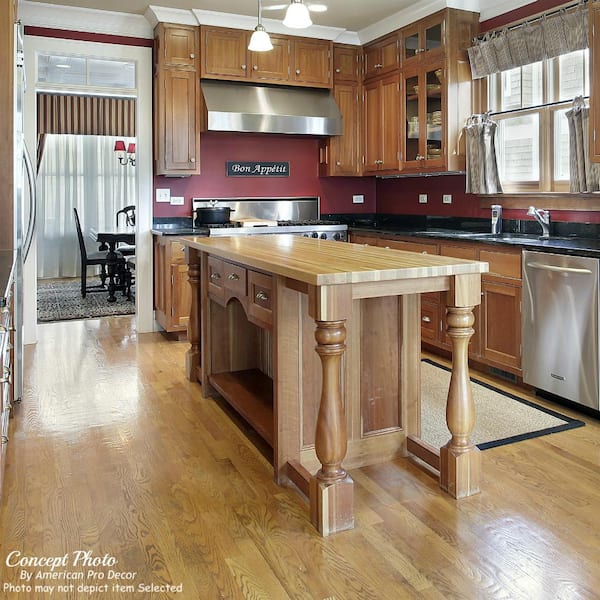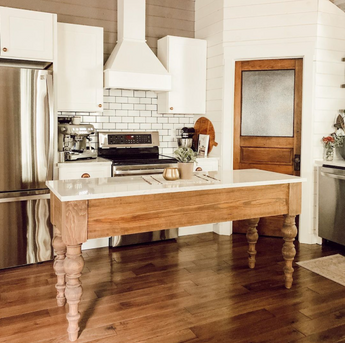The Most Effective Kitchen Island Leg Options for Modern and Traditional Kitchens
The Most Effective Kitchen Island Leg Options for Modern and Traditional Kitchens
Blog Article
Leading Factors To Consider When Selecting a Cooking Area Island Leg for Modern Kitchen Insides
In the realm of contemporary kitchen area interiors, the choice of a cooking area island leg is critical, affecting both looks and capability. Key considerations include the choice of materials that balance with contemporary design, in addition to the leg's stability and support to guarantee long-lasting performance. Additionally, elevation and proportions should be thoughtfully reviewed to maintain a natural appearance. As these aspects intertwine, they raise further questions concerning just how to achieve the excellent balance in between style and usefulness, leaving one to contemplate the implications of each choice on the general cooking area experience.
Product Choices
When it involves choosing a kitchen island leg, material choices play a crucial role in both aesthetics and functionality. kitchen island leg. One of the most typical materials consist of wood, steel, and composite alternatives, each offering prospective downsides and distinct benefits
Wood is favored for its warmth and classic charm, supplying a timeless appearance that enhances different cooking area designs. It is extremely functional, enabling for modification in terms of finishes and shades. Timber might need even more upkeep to prevent bending or damages from dampness.
Steel, on the other hand, brings a commercial and modern style to cooking area islands. Stainless-steel and wrought iron are prominent choices, known for their toughness and resistance to wear. They can withstand the roughness of day-to-day usage but may do not have the heat related to wood.
Composite products, such as engineered wood or artificial blends, supply an equilibrium between rate, longevity, and visual appeals. These choices are commonly developed to mimic the appearance of natural products while giving resistance to scratches and spills.
Inevitably, the selection of product should line up with the overall kitchen area design and planned use, ensuring that the kitchen area island leg is both practical and aesthetically appealing.
Style and Style
The design and design of a kitchen area island leg considerably add to the total visual of the area, enhancing the picked product. When picking the leg style, think about the architectural style of the kitchen. Streamlined, minimalist legs made of stainless steel or acrylic harmonize with contemporary designs, while ornate, turned wood legs enhance traditional or farmhouse aesthetics.
Furthermore, the surface of the leg can influence the aesthetic influence; a sleek chrome or matte black surface may stimulate contemporary beauty, while troubled wood speaks to rustic charm. The leg's shape additionally plays an important function-- straight, angular kinds communicate a more industrial feeling, whereas rounded or conical legs introduce a softer, more inviting look.
Integrating ornamental elements, such as carvings or decorations, can add individuality and character to the kitchen area island, additional enhancing its duty as a prime focus. Ultimately, the picked leg style must not only align with the total cooking area design yet also show the home owner's individual taste, making sure that the cooking area island comes to be a useful and harmonious centerpiece within the contemporary kitchen area interior.
Height and Proportions
Accomplishing the right elevation and percentages for a cooking area island leg is crucial for both functionality and aesthetics. Kitchen area islands usually vary in moved here height from 28 to 36 inches, relying on their planned use-- whether as a cooking surface, dining area, or work space. Requirement countertop height is around 36 inches, making it essential that the legs you choose complement this elevation to provide a seamless, incorporated look.
Percentages likewise play an important duty in the visual balance of the kitchen. A slim leg might be ideal for a modern or minimalistic island, while a much more considerable leg may be needed for rustic or standard designs.
When choosing the height and percentages of the cooking area island leg, maintain in mind the overall style theme of your kitchen area. This attention to detail not only enhances the capability of the room however additionally contributes to a visually appealing and natural interior decoration.
Stability and Support
Constantly ensuring stability and support in cooking area island legs is essential for both safety and security and performance. A well-constructed kitchen island should endure daily usage, including weight from home appliances, cooking, and social gatherings. Therefore, the selection of legs must prioritize robust products and designs that can provide sufficient support.
When assessing stability, think about the leg's material-- aluminum, steel, or wood frequently offer superior stamina compared to lighter options. Additionally, the design must feature a wide base to disperse weight uniformly and decrease the risk of tottering or tipping. Legs designed with an A-frame or cross-bracing can substantially boost stability.

Including these factors to consider will not just enhance the overall security of the cooking area room yet also improve the longevity and capability of the cooking area island, making it an important centerpiece in contemporary kitchen area interiors.
Finishing Touches
When it pertains to completing a kitchen area island, thoughtful finishing touches can Read Full Report significantly boost both its aesthetic charm and functionality. Selecting the best leg design is essential, however complementing it with proper information can transform the whole room. Consider adding decorative components such as toe kicks or walls that match the cabinetry or floor covering to produce a seamless appearance.

A natural shade scheme and product option will certainly elevate the cooking area island, making it a fascinating focal point. By paying attention to these completing touches, home owners can produce a cooking area island that is both gorgeous and useful, providing to their lifestyle and design choices.
Conclusion

In the realm of modern kitchen insides, the option of a kitchen island leg is crucial, affecting both appearances and functionality.The design and layout of a kitchen island leg substantially add to the total aesthetic of the area, matching the selected material.Achieving the best elevation and percentages for a kitchen island leg is essential for both performance and visual appeals.Consistently making my sources certain security and assistance in kitchen area island legs is vital for both security and performance.In summary, choosing a kitchen area island leg for contemporary interiors calls for careful factor to consider of product options, layout style, elevation, proportions, and security.
Report this page